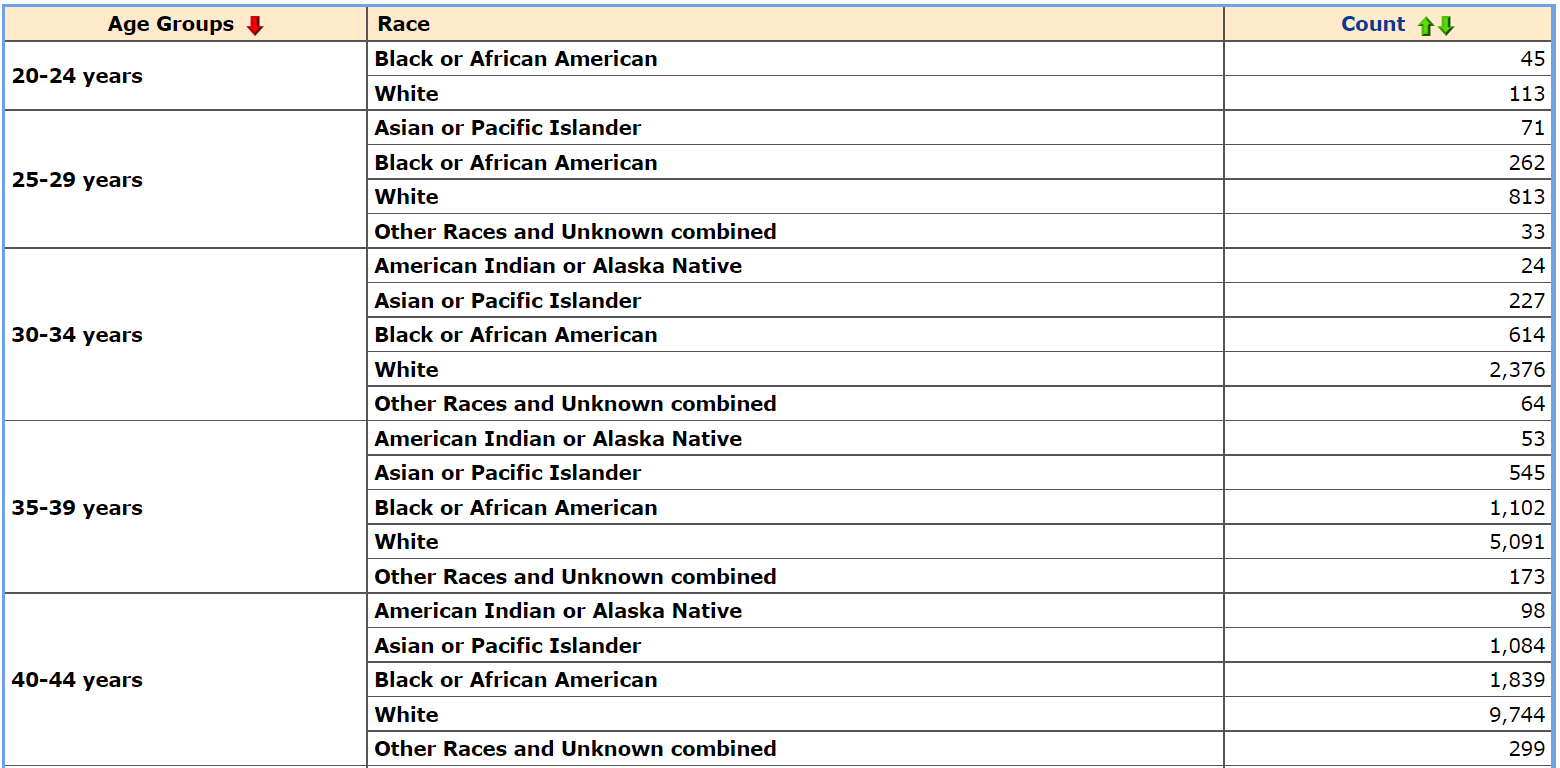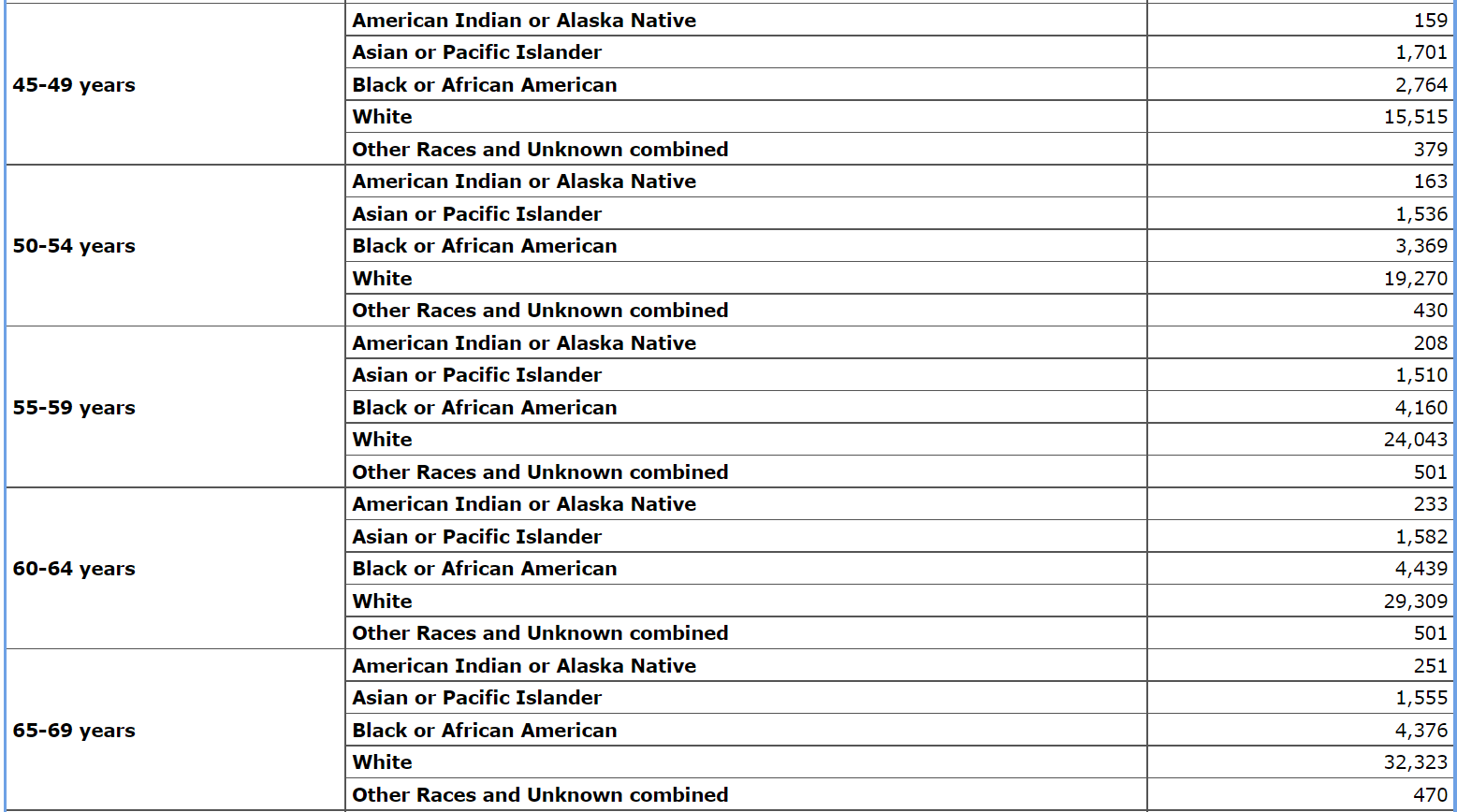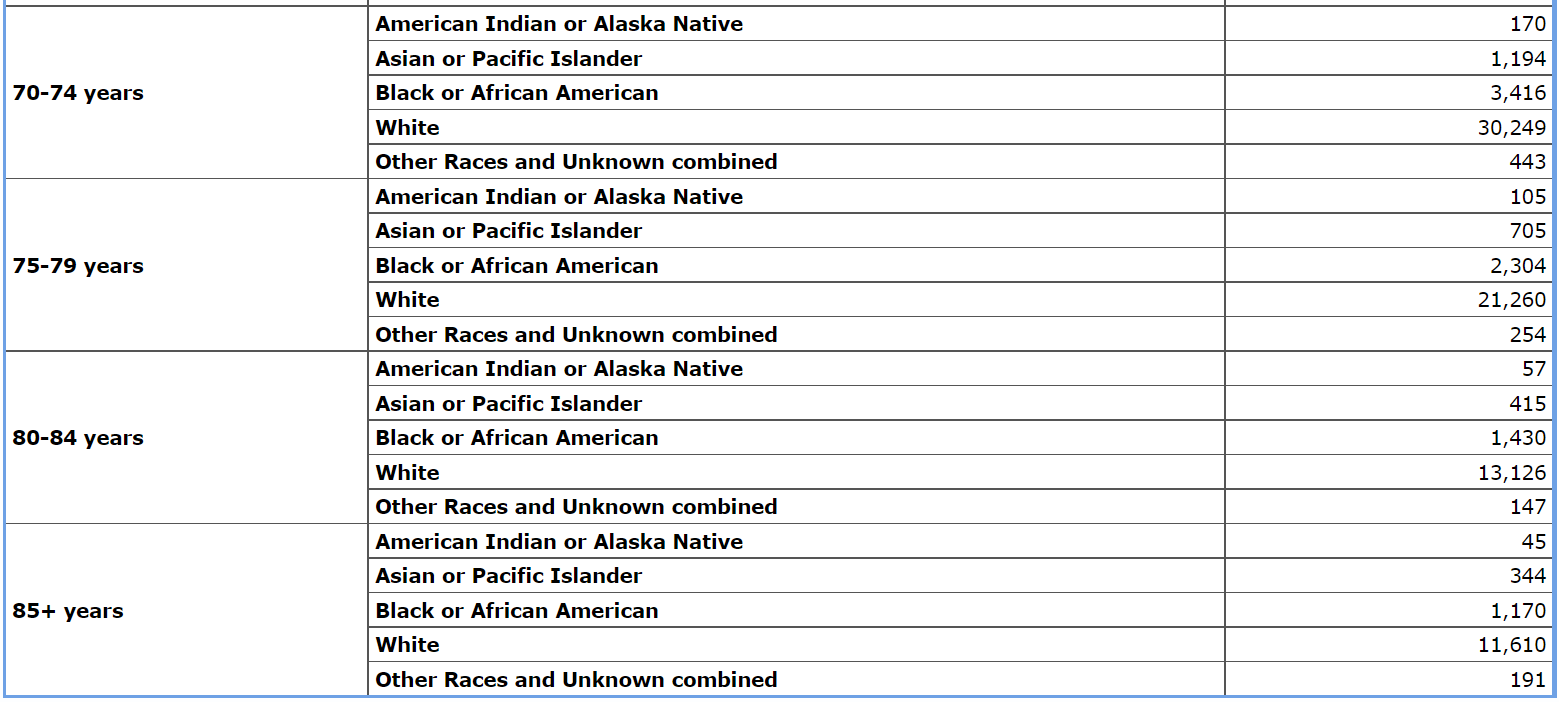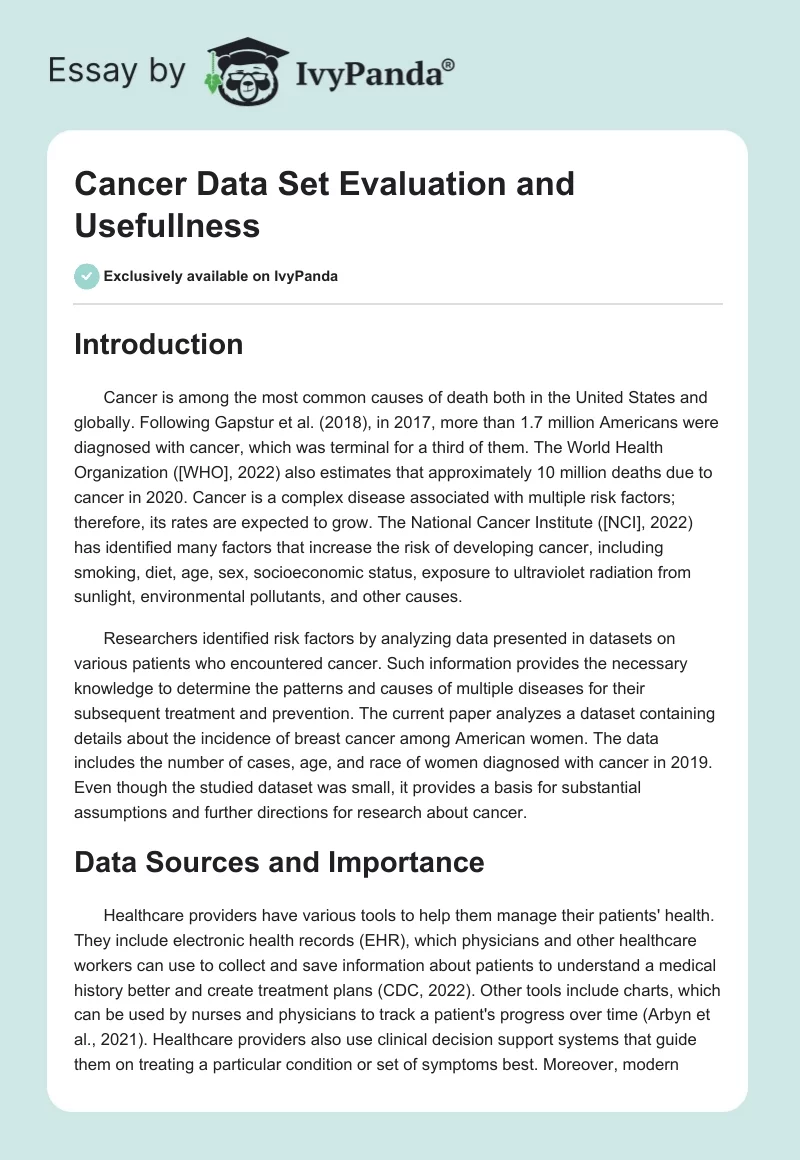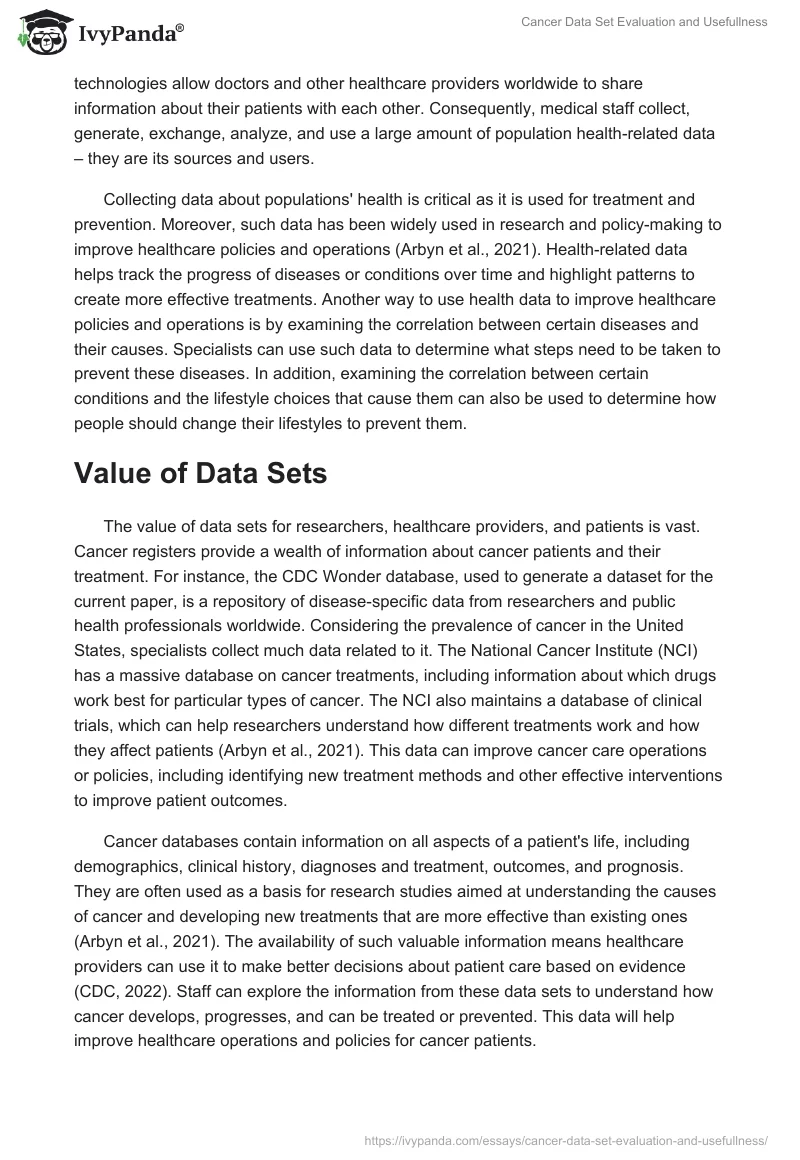Introduction
Cancer is among the most common causes of death both in the United States and globally. Following Gapstur et al. (2018), in 2017, more than 1.7 million Americans were diagnosed with cancer, which was terminal for a third of them. The World Health Organization ([WHO], 2022) also estimates that approximately 10 million deaths due to cancer in 2020. Cancer is a complex disease associated with multiple risk factors; therefore, its rates are expected to grow. The National Cancer Institute ([NCI], 2022) has identified many factors that increase the risk of developing cancer, including smoking, diet, age, sex, socioeconomic status, exposure to ultraviolet radiation from sunlight, environmental pollutants, and other causes.
Researchers identified risk factors by analyzing data presented in datasets on various patients who encountered cancer. Such information provides the necessary knowledge to determine the patterns and causes of multiple diseases for their subsequent treatment and prevention. The current paper analyzes a dataset containing details about the incidence of breast cancer among American women. The data includes the number of cases, age, and race of women diagnosed with cancer in 2019. Even though the studied dataset was small, it provides a basis for substantial assumptions and further directions for research about cancer.
Data Sources and Importance
Healthcare providers have various tools to help them manage their patients’ health. They include electronic health records (EHR), which physicians and other healthcare workers can use to collect and save information about patients to understand a medical history better and create treatment plans (CDC, 2022). Other tools include charts, which can be used by nurses and physicians to track a patient’s progress over time (Arbyn et al., 2021). Healthcare providers also use clinical decision support systems that guide them on treating a particular condition or set of symptoms best. Moreover, modern technologies allow doctors and other healthcare providers worldwide to share information about their patients with each other. Consequently, medical staff collect, generate, exchange, analyze, and use a large amount of population health-related data – they are its sources and users.
Collecting data about populations’ health is critical as it is used for treatment and prevention. Moreover, such data has been widely used in research and policy-making to improve healthcare policies and operations (Arbyn et al., 2021). Health-related data helps track the progress of diseases or conditions over time and highlight patterns to create more effective treatments. Another way to use health data to improve healthcare policies and operations is by examining the correlation between certain diseases and their causes. Specialists can use such data to determine what steps need to be taken to prevent these diseases. In addition, examining the correlation between certain conditions and the lifestyle choices that cause them can also be used to determine how people should change their lifestyles to prevent them.
Value of Data Sets
The value of data sets for researchers, healthcare providers, and patients is vast. Cancer registers provide a wealth of information about cancer patients and their treatment. For instance, the CDC Wonder database, used to generate a dataset for the current paper, is a repository of disease-specific data from researchers and public health professionals worldwide. Considering the prevalence of cancer in the United States, specialists collect much data related to it. The National Cancer Institute (NCI) has a massive database on cancer treatments, including information about which drugs work best for particular types of cancer. The NCI also maintains a database of clinical trials, which can help researchers understand how different treatments work and how they affect patients (Arbyn et al., 2021). This data can improve cancer care operations or policies, including identifying new treatment methods and other effective interventions to improve patient outcomes.
Cancer databases contain information on all aspects of a patient’s life, including demographics, clinical history, diagnoses and treatment, outcomes, and prognosis. They are often used as a basis for research studies aimed at understanding the causes of cancer and developing new treatments that are more effective than existing ones (Arbyn et al., 2021). The availability of such valuable information means healthcare providers can use it to make better decisions about patient care based on evidence (CDC, 2022). Staff can explore the information from these data sets to understand how cancer develops, progresses, and can be treated or prevented. This data will help improve healthcare operations and policies for cancer patients.
Evaluation of Cancer Data Set
Dataset was generated using the CDC Wonder service, which contains statistics on diseases including cancer (see Appendix A). Data set information:
- Data set name: Breast Cancer Incidence among Women in the United States
- Data collection source: CDC (Centers for Disease Control and Prevention)
- Geographic location: The United States
- Date of collection: 2019
- Disease: Breast cancer
- Population: American women 20-85 years old
- Information included: Incidence, race, and age.
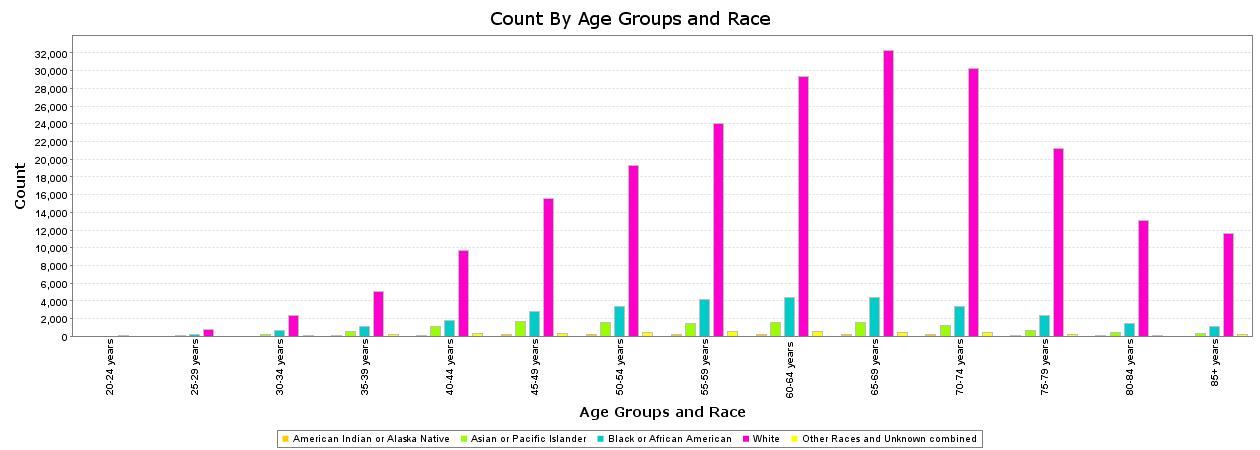
Note. A chart displaying statistics was created based on data from the CDC on breast cancer incidents among American women of various races and ages.
Trends in Data Documents
By considering the presented data on breast cancer, one can distinguish several patterns, make assumptions to explain them, or provide propositions for application:
- The number of breast cancer cases grows with the age of patients and decreases after 70 years. This information suggests an increase in disease risk with the patient’s age. The drop in the number of cases after 70 years can be explained by the fact that more than 55% of the American population are people aged 18 to 65 (The United States Census Bureau, 2020). Such data allow concluding that it is necessary to strengthen prevention and screening measures for women as their age increases. It also provides a basis for investigating the causes of increasing cancer risk with age.
- White women are more diagnosed with breast cancer than other races in America. Afro-Americans are second in the number of incidents, and Asian or Pacific Islanders are third. The significant difference in the data can be explained by the fact that more than 75% of the population in America is white, African-Americans – 13.6%, and Asian or Pacific Islanders represent more than six percent, which correlates with the number of cases (The United States Census Bureau, 2020). Nevertheless, additional statistical calculations are needed to compare the ratio of the percentage of incidents in different population groups. It is necessary to determine the rate of women susceptible to breast cancer in each group. Such data provide the basis for subsequent studies on the topics of healthcare accessibility, racism, socio-economic status, and other factors related to breast cancer diagnosis and treatment.
Changes in Operations or Policies to Improve the Quality or Efficiency of Cancer Treatment
Supporting cancer treatment and prevention effectiveness requires attention to several aspects of health care. For example, education is critical to ensure that all cancer care team members understand their roles and responsibilities. All members should be adequately trained so they can provide quality patient care. Quality measures for cancer treatment should be developed and implemented to maximize patient outcomes while minimizing costs (Arbyn et al., 2021). In addition, policies about patient safety and practice guidelines should be addressed through education and training programs (Arbyn et al., 2021). Other policies aimed at reducing cancer risks in the population include the availability of screening, sufficient numbers of specialists, coverage of care, and similar directions. Moreover, policy should also focus on reducing environmental exposure factors. In particular, it is essential to direct efforts to reduce harmful emissions into the environment, limit smoking, and take other measures.
Recommendations
To reduce the rate of cancer, people must improve their quality of life and receive better healthcare services.
- The government, together with non-governmental organizations, should increase awareness about cancer. For example, educating people about the symptoms of different types of cancer and how to prevent them. Also, educating people about what can be done at home when they get sick with cancer or how they should act if they suspect something is wrong.
- Provision of more resources for early detection and treatment. This recommendation means that all patients should be able to get access to screenings for different types of cancers and radiation treatments when necessary. There should also be more doctors who specialize in treating cancers so there are fewer delays in care for patients who need it most.
- Supporting research aimed at exploring the causes and ways to treat cancer. Modern science has made a significant breakthrough in understanding disease, for example, when studying the human genome. Continued research is required, as it will make treatment more effective and allow detecting the condition in the early stages to take action in time.
- Finally, there is a need for more funding for research into new drugs and treatments, which could help people fight this disease more effectively than before (CDC, 2022). They have yet to be widely used but could one day help save thousands.
Conclusion
Thus, medical personnel collect a large amount of data necessary for diagnosis and treatment when working with patients and in research. Such information is valuable not only for managing treatment; in large volumes, it also reveals many patterns in the development of the disease. Technology advances have made data collection, storage, and analysis more accessible, providing many opportunities for professionals. The current paper provides an example of the analysis of the dataset generated from the CDC data regarding the incidence of cancer in American women aged 20 to 85+ years.
The analysis demonstrated a significant increase in cancer cases with age, which is a crucial pattern for prevention. It also showed a considerable gap in the number of incidences between races, which the composition of the population can explain. However, such data require further research, as they may be associated with problems such as access to health services or manifestations of systemic racism. Analyzing datasets is essential for politics, as it draws attention to the issues that require regulation. For example, the current dataset highlights the importance of available screenings, which are influenced by policy. Therefore, data collection and analysis are crucial tools in supporting population health.
References
Arbyn, M., Gultekin, M., Morice, P., Nieminen, P., Cruickshank, M., Poortmans, P., Kelly, D., Poljak, M., Bergeron, C., Ritchie, D., Schmidt, D., Kyrgiou, M., Van den Bruel, A., Bruni, L., Basu, P., Bray, F., & Weiderpass, E. (2021). The European response to the WHO call to eliminate cervical cancer as a public health problem. International Journal of Cancer, 148(2), 277–284. Web.
Centers for Disease Control and Prevention. (2022). CDC Wonder. Web.
Gapstur, S. M., Drope, J. M., Jacobs, E. J., Teras, L. R., McCullough, M. L., Douglas, C. E., Patel, A. V., Wender, R. C., & Brawley, O. W. (2018). A blueprint for the primary prevention of cancer: Targeting established, modifiable risk factors. CA: A Cancer Journal for Clinicians, 68(6), 446–470. Web.
National Cancer Institute. (2022). Cancer prevention overview (PDQ®)–Patient version. Web.
The United States Census Bureau. (2020). Quick facts. Web.
World Health Organization. (2022). Cancer. Web.
Generated Dataset
